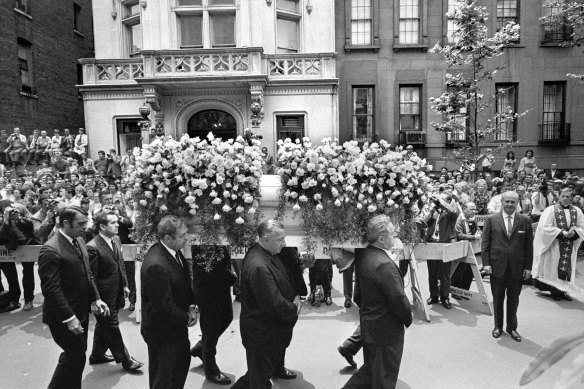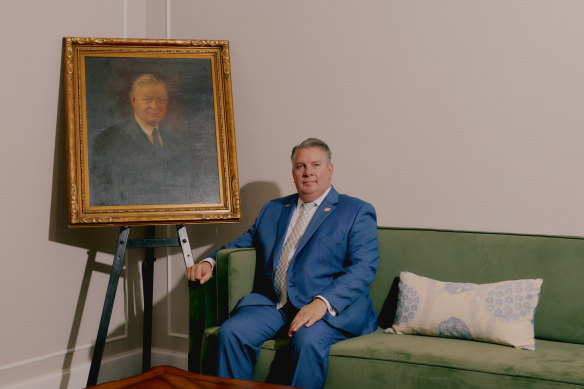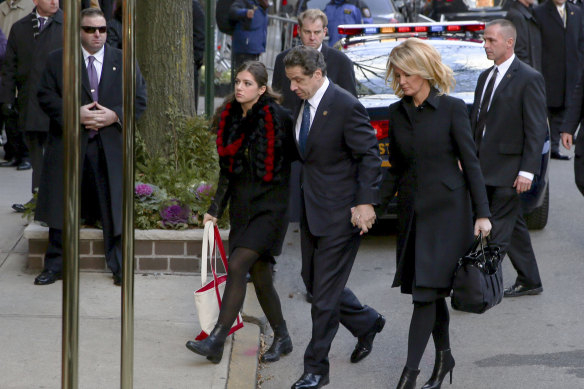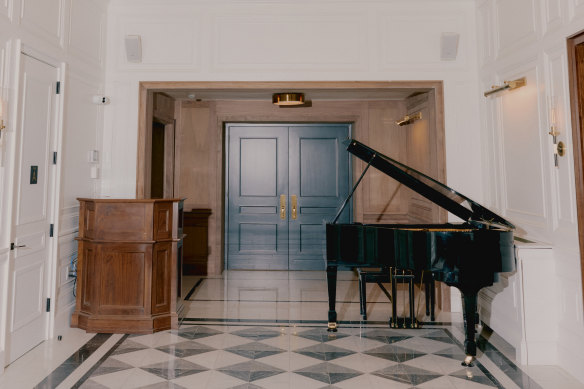
Jacqueline Kennedy Onassis. John Lennon. Greta Garbo. Jean-Michel Basquiat. Mae West. Arthur Ashe. Ivana Trump. Luther Vandross. Heath Ledger. George Balanchine. George Gershwin. Mario Cuomo. Biggie Smalls. Nikola Tesla. Celia Cruz. Joan Rivers. Aaliyah. Ayn Rand. Lena Horne. Norman Mailer. Philip Seymour Hoffman. Logan Roy.
What do these people have in common?
The answer is that, shortly after their deaths, they passed through the Frank E. Campbell funeral home on the Upper East Side of Manhattan.

After Judy Garland’s death in 1969, the streets nearby were swarmed with fans who waited hours behind police barricades.Credit: The New York Times
For more than a century, Frank E. Campbell has been the mortuary of choice for New York’s power brokers and celebrities. In some circles, to end up anywhere else would be a fate even worse than death.
Writer Gay Talese, a long-time Upper East Sider, has lost count of how many services he has attended there.
“For a certain kind of person, they must end up at Campbell as a matter of honour and status,” Talese, 92, said. “And Campbell is the rare New York business that might never close, because it will never run out of customers — because everyone dies.”
“Eventually, sure, I’ll probably have my own moment at Campbell,” he continued. “I’ll enter reclined on my back and have a moment of silence there while friends and relatives come to stare at me. It’s the final stop. The last picture show.”
Frank E. Campbell, the Funeral Chapel, occupies a five-storey building at 1076 Madison Avenue, in the heart of one of the city’s most expensive shopping districts. Black SUVs idle in the no-parking zone out the front as clients consult funeral directors.
A service might include horse-drawn carriages. Private jets and Rolls-Royce Phantoms can be reserved for grieving family members. The gold-hued coffin used for Ivana Trump’s service in 2022 at Frank E. Campbell cost a reported $US125,000. The home also offers a sarcophagus casket for more than $US150,000 ($222,500).
‘For a certain kind of person, they must end up at Campbell as a matter of honour and status.’
Writer Gay Talese
After Judy Garland’s death in 1969, the streets nearby were swarmed with fans who waited hours behind police barricades. An estimated 20,000 people went in for a glimpse of the body, which was dressed in a chiffon gown and silver slippers with buckles.
Mourners included Mickey Rooney, James Mason, Lauren Bacall and Otto Preminger. (When their own time came, Bacall and Preminger ended up at Frank E. Campbell, too.) After the service, pallbearers carried the coffin, which had been covered in yellow roses, to a hearse. Photos depict Garland’s three children – Liza Minnelli, Lorna Luft and Joey Luft – all dressed in black.
“I was 16 and still remember being scared of the crowds,” Lorna Luft recalled. “I remember Liza saying, ‘We’ll do this together. It’s the three of us.’ She was the oldest and had more awareness of what the media was saying about mum’s death. But the crowds were sad about losing the legend. She was Dorothy to them. We lost our mum, and we had to share her with the world that day. I still can’t look at yellow roses.”
“My family will always be grateful for how Campbell protected us as kids,” she continued. “One reason they’re still considered the best is because of their code of silence. They don’t let anything leak out. That is extremely rare in this day and age.”
In 1980, after the murder of John Lennon, the Frank E. Campbell team arranged for a decoy hearse to lure away the swarms of journalists camped out front.
In 1994, when Jacqueline Kennedy Onassis died in her Fifth Avenue apartment, a Frank E. Campbell undertaker slipped through the crowds outside her building and embalmed the body in her home.

The Frank E. Campbell funeral home, which recently undertook a $US20 million renovation. Credit: Vincent Tullo/The New York Times
In 2023, after Robert De Niro’s grandson, Leandro De Niro Rodriguez, died from an accidental drug overdose, family friends including Christopher Walken and Harvey Keitel attended the service at Frank E. Campbell. A security guard kept watch, telegraphing to the paparazzi that they approached at their own peril.
The home’s impenetrability made it a tantalising target for the news media, said George Rush, who co-wrote the Rush & Molloy gossip column with Joanna Molloy for The Daily News.
“The paparazzi have always been part of the Campbell experience,” Rush said. “Campbell confronts them while they try to get shots of the mourners. At the same time, the deceased becomes defined by the images of who attended their Campbell funeral.
He added: “It’s a tabloid ritual, to send some young reporter to stake out Campbell to try to buttonhole a mourner, to extract that poetic final thought about the deceased. But it’s always a tough assignment. Campbell’s reputation for privacy is well earned.”
‘I never discuss our clients’
The inner workings of Frank E. Campbell are almost as mysterious as the afterlife itself. Its pallbearers, doormen, cosmeticians and embalmers honour a code of silence when it comes to clients. Its website makes no mention of its illustrious customers.
People who visit the home may not realise that it is owned by Service Corporation International, the nation’s largest chain of funeral homes and cemeteries. With annual revenue in the billions, the company developed its Borg-like empire by acquiring scores of family run mortuaries across North America.
‘We appreciate that people are curious, but privacy is our standard.’
Frank E. Campbell president William Villanova
William Villanova, the president of Frank E. Campbell since 2018, says discretion is a crucial part of his job.
“We appreciate that people are curious, but privacy is our standard,” said Villanova, 54. “But people try. They sure do try. We’ve seen them hiding inside cars, behind cars, behind trees. Anything to get a glimpse.”
“I never discuss our clients,” he added.
In a break with tradition, Frank E. Campbell allowed a reporter from The New York Times to spend some time within its walls. The decision to loosen up a bit coincided with a $US20 million renovation that brings the home into the 21st century.
The building’s sombre brown facade is now a more welcoming off-white. There is even a new rooftop patio with a nightclub-worthy name, The Terrace at 1076.
Villanova, who once made the cover of American Funeral Director magazine, wears an American flag pin on the lapel of his suit jacket. It was given to him by a Secret Service agent who stood guard at a service he helped arrange. No, he would not divulge whose corpse was in the casket that day.

Bill Villanova, funeral director, with a painting of the namesake of the Frank E. Campbell mortuary.Credit: Vincent Tullo/The New York Times
On one of my return visits, Villanova re-created a client planning meeting in his office, a plain room furnished with little more than a wooden desk, funeral industry excellence awards and a painting of the founder, Frank Ellis Campbell. We were joined by a fellow funeral director, James Pescitelli, and a representative from the Rubenstein Public Relations firm.
“Let’s say a high-profile client was with us right now,” Villanova said. “Take it from here, James.”
Pescitelli, who entered the trade as a teenager at the Hanley Funeral Home on Staten Island, walked me through a services and amenities portfolio filled with images of private jets and security agents. He paused at a photo of a scuba diver placing a starfish-shaped sculpture made out of human ashes on the ocean floor.
“We have the ability to send a client’s ashes to a coral reef off the coast of Miami,” he said. “It’s a segment of reef we have access to.”
Frank E. Campbell can also arrange to have a loved one’s ashes blasted into outer space, as the section titled “An Out-of-This-World Memorialisation” made clear. The description of the service noted: “There’s no more compelling send-off for someone who loves science fiction, marvels at space or simply longs to be at one with the cosmos.”
Pescitelli explained: “The family gets the co-ordinates of where they will be sent into space, and it goes up in a rocket.”
Villanova fielded some hot-seat questions.
‘We have the ability to send a client’s ashes to a coral reef off the coast of Miami.’
Funeral director James Pescitelli
Frank E. Campbell’s prices are not public. Could he talk numbers?
“Money is what someone pays,” he said. “Our business is based on value.”
He allowed that the cost of a service could range from $US10,000 to $US50,000. Beyond that, he said, “there can be no end in sight”.
The home has also handled services for notorious figures like Jeffrey Epstein and the crime boss Frank Costello. Is everyone welcome at Frank E. Campbell?
“We do not judge the dead,” Villanova said. “Maybe the public saw someone a certain way, but to someone else, that was their father or their mother. We see the grandchildren crying.
“Are we aware of what is happening with certain clients outside in the media?” he continued. “Of course we are. But everyone is entitled to grieve and mourn.”
The Valentino riot
Long ago, funerals in New York tended to be simple affairs held in private homes. Services for average citizens became less austere – and more expensive – thanks, in part, to Frank Ellis Campbell, a death-industry pioneer who popularised innovations like motorised hearses, paid death notices and sumptuous viewing suites with names like the Broadway Room.
Campbell was born in a small town in Illinois in 1872. As a teenager, he built caskets for a local undertaker. He moved to Manhattan to apprentice at the Stephen Merritt Burial and Cremation Co.

Then New York governor Andrew Cuomo, his daughter Michaela Kennedy-Cuomo and girlfriend Sandra Lee arrive at the Frank E. Campbell for his father Mario Cuomo’s wake in January 2015.Credit: Chang W. Lee/The New York Times
In 1898, he opened a parlour of his own on West 23rd Street. From the start, he embraced marketing. A typical newspaper ad boasted that his funeral home provided Pierce-Arrow limousines. Another made the claim that his staff was composed of “World Wide Known Undertakers.” In 1915, he moved his operation to a grand building on Broadway and West 66th Street.
He made his reputation as the mortician to the stars in 1926, when he arranged the funeral of the silent film heartthrob Rudolph Valentino.
Valentino, 31, was in New York to promote his latest adventure romance, The Son of the Sheik, when he collapsed at the Hotel Ambassador and died of sepsis a few days later. His fans were inconsolable. There were reports of women dying by suicide, including the account of an actress in London who fatally ingested poison surrounded by pictures of the star.
Campbell had Valentino’s body prepared for a public viewing in his Gold Room. He reportedly enlisted women to faint for photographers and offered $US1 to barflies to add heft to the crowd.
His preparations proved unnecessary. On a drizzly Tuesday, thousands of people, watched over by police officers on horseback, gathered outside the home. When the doors opened, there was a stampede. Windows were shattered, brawls broke out and people were trampled as mourners fought over souvenirs like flowers and strips of wallpaper.
A front-page headline in The New York Times read: “Thousands in Riot at Valentino Bier; More Than 100 Hurt.”

The lobby of the Frank E. Campbell funeral home.Credit: Vincent Tullo/The New York Times
“The rioting was without precedent in New York,” The Times reported, adding that many of those present “suffered discomfort and rough handling for hours for whatever satisfaction it gave them to be hustled by the dead screen star’s coffin and to gaze for an instant on his drawn, white face”.
Campbell died eight years later, but his name would live on. Twentieth-century figures who made stops at his home en route to the golden shore included William Randolph Hearst, Irving Berlin, Elizabeth Arden and Igor Stravinsky. As celebrities began to guard their privacy, the home made discretion part of the service.
Campbell’s wife, Amelia Klutz Campbell, carried on the business and moved it to its current address in 1938. After her death in 1954, the death industry underwent a change as conglomerates began to take over family run homes. Frank E. Campbell was eventually acquired by one of these concerns, Kinney Services. In 1971, it was bought by Service Corporation International.
Service Corporation International, a Texas-based conglomerate that went public in 1969, now operates more than 1900 cemeteries and funeral homes, including Riverside Memorial Chapel and the Walter B. Cooke Funeral Home in New York. Its founder, Robert L. Waltrip, said he aimed to do for the death industry what McDonald’s and Burger King had done for the food business. And he was not shy about trumpeting his company’s profits.
“People that don’t buy our stock just don’t like money,” he told The Times in 1993. “It’s the greatest buy I’ve ever seen. People are always going to die.”
Over the Rainbow
Even in the digital age, little has leaked out to the public about Frank E. Campbell, with the exception of the occasional morbid tidbit.
In 2017, New York City tabloids reported on a lawsuit filed by two brothers who learned that their mother’s remains had been accidentally mixed with the ashes of another client. According to court records, the case was “amicably adjusted and settled”.
The veil was penetrated more directly in 2015 when Elizabeth Meyer, a former family service director at Frank E. Campbell, wrote a memoir, Good Mourning. Among other anecdotes, she dished about an incident involving two women who called the home to inquire about a service for the same philandering man, resulting in separate wakes.
I asked Villanova his opinion of such leaks.
“We pay these things no mind,” he said.
On a recent afternoon, when the chapel’s renovation was complete, Villanova showed me around one last time. Maybe because he was in a good mood, he bent his cardinal rule: he discussed a Frank E. Campbell client, albeit one from more than 50 years ago.
“A woman who visited Campbell recently told me a story about the Judy Garland funeral I’d never heard before,” he said. “She said her father lived in one of the town houses next door, and on that day, he opened his windows and sat at his piano to play Over the Rainbow to the crowds.”
“Do I think that was inappropriate?” he continued. “No. I think it was perfect. Because he was helping them grieve.”
This article originally appeared in The New York Times.
Get a note directly from our foreign correspondents on what’s making headlines around the world. Sign up for the weekly What in the World newsletter here.









 Add Category
Add Category